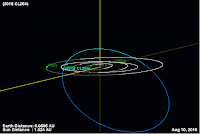Asteroid (357024) 1999 YR14 passed by the Earth at a distance of 8 348 000 km
(21.7 times the average distance between the Earth and the Moon, or 5.58% of
the average distance between the Earth and the Sun), at about 11.45 am
GMT on Thursday 1 September 2016. There was no danger of
the asteroid hitting us, though had it done so it would have presented a
considerable threat. (357024) 1999 YR14
has an estimated equivalent
diameter of 270-860 m (i.e. a spherical body with the same mass would be 270-860 m in diameter), and an asteroid of this size
would be expected to pass through the atmosphere and directly impact the ground with a
force of 800-25 000 megatons (47 000-1 470 000 times the
explosive energy of
the Hiroshima bomb), causing devastation over a wide area and creating a
crater roughly 4-11 km across, and resulting in global climatic problems
that
could last for decades or even centuries.
The calculated orbit of (357024) 1999 YR14. JPL Small Body Database.
(357024) 1999 YR14 was discovered on 31 December 1999 by the Lowell Observatory Near-Earth-Object Search, at Anderson Mesa Station, near Flagstaff, Arizona. The
designation 1999 YR14 implies that it was the 367th asteroid (asteroid R14)
discovered in the second half of December 1999 (period 1999 Y), while
the designation 357024 implies that it was 357 024th asteroid ever
discovered (asteroids are not given this longer designation immediately
to avoid naming double or false sightings).
(357024) 1999 YR14 has a 777 day orbital period and an elliptical orbit tilted at
an angle of 3.72° to the plain of the Solar System that
takes it from 0.99 AU from the Sun (i.e. 99% of the average distance at
which the Earth orbits the Sun) to 2.31 AU from the Sun (i.e. 231% of
the average distance at which the Earth orbits the Sun, considerably outside the orbit of the planet Mars). It is therefore classed as an Apollo
Group Asteroid (an asteroid that is on average further from the Sun than
the Earth, but which does get closer). This means that close
encounters between the asteroid and Earth are very common, with the
last thought to have happened in August 1999 and the next predicted in August 2022. (357024) 1999 YR14 also has frequent close encounters with the
planet Mars, with the last thought to have occurred in June 1972
and
the next predicted for March 2087. As
an asteroid possibly larger than 150 m in diameter that occasionally
comes within 0.05 AU of the Earth, (357024) 1999 YR14 is also classified
as a Potentially Hazardous Asteroid.
See also...
 Asteroid (281375) 2008 JV19 passes the Earth. Asteroid (281375) 2008 JV19 passed by the Earth at a distance of 17 640 000 km
(45.9 times the average distance between the Earth and the Moon, or 11.8% of
the average distance between the Earth and the...
Asteroid (281375) 2008 JV19 passes the Earth. Asteroid (281375) 2008 JV19 passed by the Earth at a distance of 17 640 000 km
(45.9 times the average distance between the Earth and the Moon, or 11.8% of
the average distance between the Earth and the...  Asteroid 2016 QA2 passes the Earth. Asteroid
2016 QA2 passed by the Earth at a distance of 86 570 km (0.23 times
the average distance between the Earth and the Moon, 0.06% of...
Asteroid 2016 QA2 passes the Earth. Asteroid
2016 QA2 passed by the Earth at a distance of 86 570 km (0.23 times
the average distance between the Earth and the Moon, 0.06% of... Asteroid 2016 CL264 passes the Earth. Asteroid 2016 CL264 passed by the Earth at a distance of 8 723 000 km
(22.7 times the average distance between the Earth and the Moon, or 5.83% of
the average distance between the Earth and the Sun), slightly after 6.05 pm
GMT on Monday 8 August...
Asteroid 2016 CL264 passes the Earth. Asteroid 2016 CL264 passed by the Earth at a distance of 8 723 000 km
(22.7 times the average distance between the Earth and the Moon, or 5.83% of
the average distance between the Earth and the Sun), slightly after 6.05 pm
GMT on Monday 8 August...
Follow Sciency Thoughts on Facebook.

